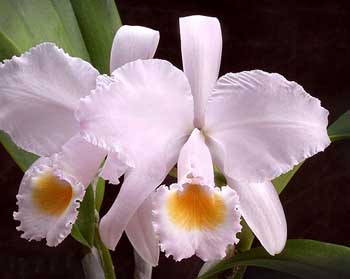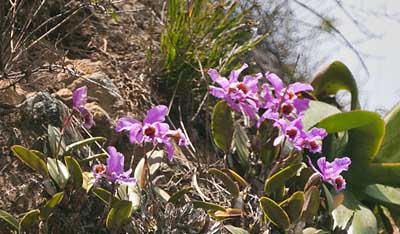|
Welcome to the AOS Beginner's Newsletter. We will be sending you monthly tips on how to grow orchids and help you get them to bloom again. In addition to the information presented here, we invite you to visit the AOS website at www.aos.org and check out the information found under ORCHID INFORMATION > ORCHID BASICS.
Cattleyas
Queen of the Orchids
 Although phalaenopsis may be responsible for the current popularity of orchids as house plants, for many people, the image of an orchid flower is a Cattleya,
such as Cattleya schroderae pictured at left. Cattleyas have long been a symbol of luxury and for generations, have decorated everything from women's bosoms to boxes of confections. While for the orchid hobbyist they may be more challenging subjects for the home, there are hybrids or species that can be found to thrive in nearly any
location. With their myriad variation of colors, patterns, sizes and shapes, cattleyas are well worth the challenge. As an added bonus, cattleyas can make you swoon with their intoxicating aromas. Sitting on my desk is a Cattleya gaskelliana var. coerulea whose fragrance is reminiscent of hyacinth and other spring bulbs. Cattleyas are truly "The Queen of Orchids". Although phalaenopsis may be responsible for the current popularity of orchids as house plants, for many people, the image of an orchid flower is a Cattleya,
such as Cattleya schroderae pictured at left. Cattleyas have long been a symbol of luxury and for generations, have decorated everything from women's bosoms to boxes of confections. While for the orchid hobbyist they may be more challenging subjects for the home, there are hybrids or species that can be found to thrive in nearly any
location. With their myriad variation of colors, patterns, sizes and shapes, cattleyas are well worth the challenge. As an added bonus, cattleyas can make you swoon with their intoxicating aromas. Sitting on my desk is a Cattleya gaskelliana var. coerulea whose fragrance is reminiscent of hyacinth and other spring bulbs. Cattleyas are truly "The Queen of Orchids".
If you have not grown cattleyas before, don't let the word "challenging" intimidate you! With their wide variety there are surely cattleyas suitable for the most basic in-home culture. For the sake of this article, the name "Cattleya" is being used in its broadest sense to include all Cattleya species, their hybrids and intergeneric hybrids with related genera. It should also include the recently transferred Brazilian laelias, although some of those fall outside of the parameters of culture being discussed here. For instance, what was formerly known as "rupicolous laelias" is a group of orchids best left to experienced orchid growers.
Rather than provide lengthy culture protocols here, we will refer you to the
Cattleya
culture sheet
for beginners,
and the two linked in the next paragraph. We would rather go over a few of the more important points of cattleya culture
and mention a few of the "types" of cattleyas.
We can usually adjust our cultural "practices" (watering, fertilizing, potting) to suit certain orchids, but we may not be able adjust where we can grow a plant. We may be limited with working with the space we have available. Let's take a quick look at the
regular AOS culture sheet for
Phalaenopsis, the subject of our last newsletter and compare it with the sheet for
Cattleya. Note that light is the biggest difference. While many cattleyas, especially hybrids, are adaptable to in-home growing, if they do not get enough light, they will not flower, or flower poorly. While phalaenopsis are decidedly low-light plants of the inner jungle, cattleyas are orchids of the montane forests often growing high in the treetops. Some species, like Cattleya percivaliana, can be found growing on fully exposed cliffs
as shown in the photo below.

If you are anxious to try a few cattleyas,
make sure that you have a bright enough spot to grow them or select plants that
will do well under lower light. Otherwise you may have disappointing results. Most cattleyas prefer filtered light while nearly all will adapt gradually to bright light providing that you adjust other cultural factors such as water, ventilation and humidity.
 
Just like any orchid, if you have the right place to grow the plant, it is very easy! There are a few broad cultural concepts that apply to nearly all cattleyas, whether species or hybrids. We covered their need for brighter light above. Another difference between catts and phals is their need for water. Notice that cattleyas are sympodial orchids while phalaenopsis are monopodial
orchids (see
glossary). Unlike phals, cattleyas have pseudobulbs that can store water and nutrients for extended periods. We need to adjust our potting and watering practices so that cattleyas receive less water than phalaenopsis. This means sphagnum moss is not as suitable for cattleyas as it is for phalaenopsis. Most experienced cattleya growers water their plants on a wet to dry cycle. That is, they do not water their plants until they are just approaching dryness, but not totally dry (except in winter for some species). Cattleya roots can rot if they are kept too wet.
Phalaenopsis are in growth throughout most of the year and can be repotted in spring or summer if they are not in flower. Cattleyas on the other hand, are more seasonal in growth and should not be repotted unless there are active green root tips.

The photograph at left shows a good representation of the diversity of cattleyas from the full-sized standard
Cattleya Illustrious in the back to the yellow minicatt, Rhyncholaeliocattleya Beaufort Gold, in the foreground. As you can see, there is something for every space and taste. If you have the space in a bright east or south/southwest window or a bright sunroom, a standard
Cattleya species or hybrid will certainly add the "wow" factor to your home. Guests never fail to admire an inflorescence of large, fragrant cattleyas. Hybrids are probably easier to start with. Their complex gene pool adds "hybrid vigor" to the plants and they are adaptable to a wider range of cultural factors.
Rlc. George King is among our favorites for its fragrant peach-colored flowers and ease of growth. If your space is more limited,
Cattleya Beaufort and its hybrids are good choices. Not only are the plants "mini" they are more tolerant of lower light and cooler temperatures. Multifloras made with bifoliate Cattleya species or
Guarianthe parents produce clusters of smaller, often starry, flowers in bright colors. Although they can be tall, a six-inch pot can accommodate a mature plant that will produce several heads of flowers.
There are endless cattleyas to choose from.
Greg Allikas
June 2011
|

